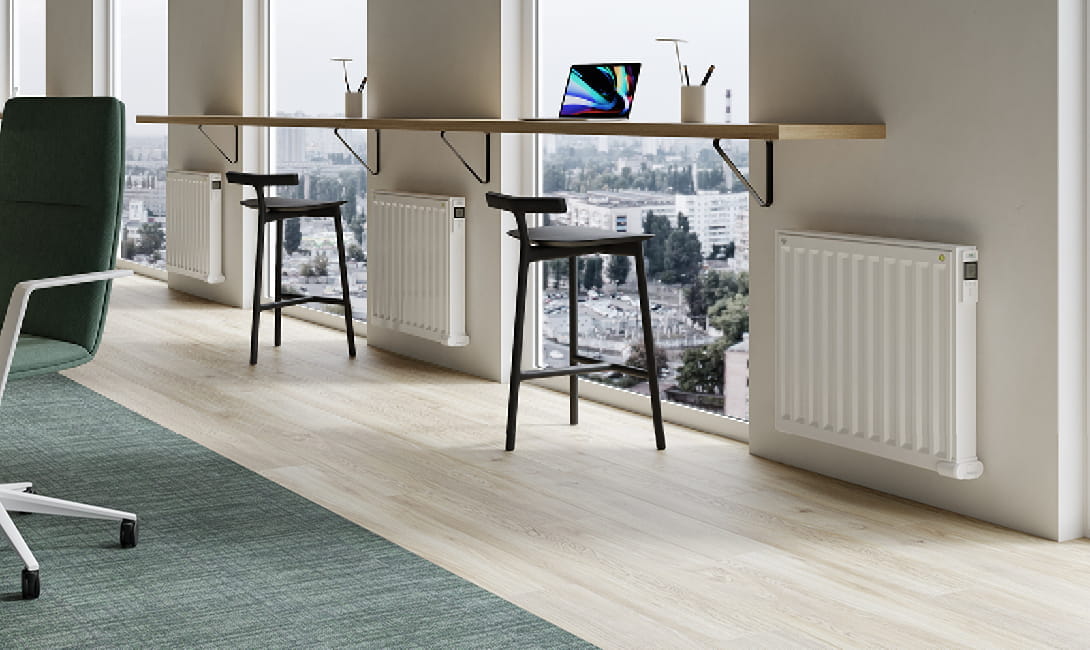- Sizing of products
- Electrical heating
- Insights
- Radiators
- Work smarter
An expert guide to sizing oil-filled electric radiators
How do oil-filled electric radiators work?
Oil-filled electric radiators are great for effectively heating a room or boosting the central heating system. ‘Oil-filled’ here refers to the reservoir of thermal oil inside the radiator body. In case of Purmo radiators this is an environmentally-friendly vegetable oil. An electrical heating element immersed in the oil is heated when the power is turned on. This converts electric energy into heat, which it then transfers to the surrounding oil. As a result, warmth is transmitted evenly to the radiator body and the air in the room.
Discover more details in our guide to choosing the right oil-filled radiator
Sizing oil-filled electric radiators
To create a comfortable indoor climate with electric radiators, it’s important that they are sized correctly and have sufficient wattage to heat the entire room. Various factors need to be taken into account in order to determine which size electric radiator you need. These include:
- Room size: the exact room size reveals the amount of air the electric radiator should be able to heat. A radiator that is too small will struggle to heat the entire room, while an electric radiator that is too large will use more energy than needed and unnecessarily drive up the energy bills.
- Orientation: depending on the orientation of the room, it might catch more direct sunlight, which affects the required heat output and thus also the radiator’s size.
- Windows: if a room has large windows or a lot of windows, there is likely more heat loss and you’ll need a larger electric radiator to compensate.
- Insulation: a building that is well insulated will retain heat longer and will need smaller radiators to effectively heat the rooms compared to a building that is leaking heat.
- Location / climate: where you live, and in particular the average outdoor temperature, also affects the recommended size of your oil-filled electric radiator. The cooler the overall climate, the higher power per square meter is required when heating.
- Other heating sources: if additional heating sources, such as underfloor heating or a fireplace, are present in the room, you’ll likely need a smaller electric radiator than for a room that’s only radiator heated
A rule of thumb for sizing oil-filled electric radiators is an average of 100 W per square metre floor space. It’s important to note that this is a very general guideline for a standard house with standard insulation and standard ceiling heights. If, for example, the room is poorly insulated and faces north, it will be necessary to increase the size of the oil-filled radiator(s). A colder climate will also increase the required power. In a Nordic climate, for example, the average is 120 W per square metre floor space.
Within our range of electric radiators we offer a variety of sizes and outputs to suit various rooms. Moreover, to help our customers size their oil-filled electric radiators correctly, we provide various user-friendly calculator tools. If you don’t know the exact heat demand of a room, you can easily find out with the help of our heat demand calculator. Then use our electric radiator calculator to size your oil-filled electric radiators correctly.
Discover our complete range of electric radiators
Enjoy maximum efficiency when using oil-filled electric radiators
Electric radiators are already very efficient by design as they convert every watt of electricity into usable heat. An oil-filled radiator that is sized correctly will help to increase energy efficiency and creates a comfortable warmth without wasting energy. Moreover, when the electric radiator is equipped with an accurate electronic thermostat, like our Yali Digital Plus for example, users can control the room temperature much more precisely, which ensures you only use the exact amount of energy you need.
If you have any questions about how to size an oil-filled electric radiator correctly or want a personalised recommendation from our heating experts, don’t hesitate to reach out.

